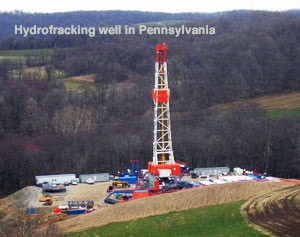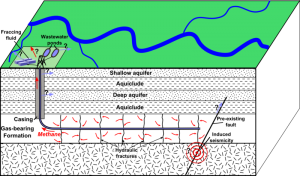“What is Hydraulic Fracturing?”, out of every ten natural gas wells, nine use a hydro-fracking tool. This process allows water, sand and chemicals to cause damage to the rocks due to pressurization underground, following this process natural gases of the rocks are then released. The fluid that returns the surface through the well and once the process is completed is known as flock back.
It was once assumed that oil and gas reserves that were unusable due to their location are now useable due to hydraulic fracturing. The use of this tool has allowed us to reach these reserves and have an increase in gas production by 2040 according to the Energy Information Administration. However, this may be a positive thing for some industries many question whether hydraulic fracturing is safe or not.
The article states the procedure of hydraulic fracturing which begins with the large amount of water that is used, in the United States alone an estimated 70 to 140 billion gallons of water was used to get to these wells, which some state is a ridiculous amount. With 1 well using an estimated 1 – 8 million gallons of water for the process many think that this large consumption is a concern for ecological impacts to aquatic resources. Furthermore, the chemicals used in hydraulic fracturing make up about 2% of the volume of the fluid, this may seem to be a small percentage but on a larger operation scale the chemicals can range up to 300 tons of chemicals. The chemicals used are also known to be hazardous and are recommend for immediate disposal and could potentially be injected into the underground system that produces our drinking water.
The Environmental Protection Agency states that there have been no incidents reported regarding the contamination of water due to hydraulic fracturing however, there still remains much concerns regarding the fluids that are released that could be causing potential contamination. The chemicals are set to ensure the maximum effectiveness of the job but are still consider non-harmful by the EPA.
Not only does hydraulic fracturing have the compound released but it also Volatile Organic Compounds into the atmosphere. About 50 percent of hydraulic fracturing fluid is recovered from each process and the rest evaporates, resulting in acid rain and contaminated air.
In conclusion, hydraulic fracturing is a new process that has not had much research done into it, although many suggest that it is problem to human health others have stated that they are not able to come to these conclusions just yet.
Below is an image of how hydraulic fracturing works with the shallow aquifier, aquiclude and deep aquifer. There is also an image of hydraulic fracturing in Pennsylvania.

 http://www.dangersoffracking.com
http://www.dangersoffracking.com
http://www.epa.gov/hydraulicfracturing/process-hydraulic-fracturing
https://www.propublica.org/special/hydraulic-fracturing-national

